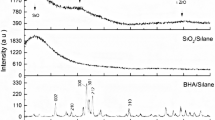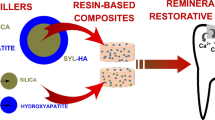Abstract
The aim of this in vitro study was to evaluate the effect of adding nano-crystalline fluorine hydroxyapatite (FHAp) bioceramic into dental adhesive on the mechanical properties and bonding strength to dentin substrate. FHAp was synthesized using a sol–gel method and characterized using x-ray diffraction (XRD), Fourier transform infrared spectroscopy (FTIR), and scanning electron microscopy (SEM). Citric acid was used as the coupling agent. The fillers were added to an ethanol-based experimental dental adhesive containing Bis-GMA, TEGDMA, and HEMA (weight ratio 2:1:1). Camphorquinone (0.1%w) and ethyl-4-dimethylaminobenzoat (0.1%w) were used as photo-initiator and co-initiator for photo-polymerization at the weight ratios of 0, 0.2, 0.5, 1, and 2%. Flexural strength and modulus of photo-polymerized specimens were measured using a three-point bending test (n = 10 for each group). Degree of conversion (DC) was measured using FTIR. Microtensile bond strength test (μTBS) to bovine dentin was measured (n = 10 for each group). The data were analyzed using one-way ANOVA and Tukey post hoc tests (α = 0.05). Results showed that the maximum flexural strength and modulus were obtained by adding 0.2 and 1% FHAp, respectively. Therefore, the FHAp fillers made the adhesive stiffer but more brittle up to 1% w/w. Adding 2% fillers decreased the mechanical properties and precipitation of some fractions of fillers was observed. The SEM imaging showed an integrated interface between fillers and the resin matrix. Moreover, the DC was not affected by the filler content and all samples showed more than 98% of conversion. Maximum μTBS was obtained in 1%-filled specimen. In conclusion, adding 1% w/w FHAp bioceramic fillers may improve the bonding strength to the dentin substrate. More studies are needed to evaluate the bioactivity of FHAp-filled dental adhesives.







Similar content being viewed by others
References
Ferracane, J.L.: Resin-based composite performance: are there some things we can’t predict? Dent Mater. 29(1), 51–58 (2013)
Opdam, N., Bronkhorst, E., Loomans, B., Huysmans, M.-C.: 12-year survival of composite vs. amalgam restorations. J Dent Res. 89(10), 1063–1067 (2010)
Li, F., Weir, M.D., Fouad, A.F., Xu, H.H.: Effect of salivary pellicle on antibacterial activity of novel antibacterial dental adhesives using a dental plaque microcosm biofilm model. Dent Mater. 30(2), 182–191 (2014)
Spencer, P., Ye, Q., Park, J., Topp, E.M., Misra, A., Marangos, O., et al.: Adhesive/dentin interface: the weak link in the composite restoration. Ann Biomed Eng. 38(6), 1989–2003 (2010)
Donmez, N., Belli, S., Pashley, D.H., Tay, F.: Ultrastructural correlates of in vivo/in vitro bond degradation in self-etch adhesives. J Dent Res. 84(4), 355–359 (2005)
Spencer, P., Ye, Q., Misra, A., SEDP, G., Laurence, J.: Proteins, pathogens, and failure at the composite-tooth interface. J Dent Res. 93(12), 1243–1249 (2014)
Zhang, K., Wang, S., Zhou, X., Xu, H., Weir, M., Ge, Y., et al.: Effect of antibacterial dental adhesive on multispecies biofilms formation. J Dent Res. 94(4), 622–629 (2015)
Cocco, A.R., da Rosa, W.L.D.O., da Silva, A.F., Lund, R.G., Piva, E.: A systematic review about antibacterial monomers used in dental adhesive systems: current status and further prospects. Dent Mater. 31(11), 1345–1362 (2015)
Corrêa, J.M., Mori, M., Sanches, H.L., Cruz, A.D.D., Poiate, E., Poiate, I.A.V.P.: Silver nanoparticles in dental biomaterials. Int J Biomater. 2015, (2015). https://doi.org/10.1155/2015/485275
Zhang, K., Li, F., Imazato, S., Cheng, L., Liu, H., Arola, D.D., et al.: Dual antibacterial agents of nano-silver and 12-methacryloyloxydodecylpyridinium bromide in dental adhesive to inhibit caries. J Biomed Mater Res B Appl Biomater. 101(6), 929–938 (2013)
Zhang, N., Weir, M.D., Romberg, E., Bai, Y., Xu, H.H.: Development of novel dental adhesive with double benefits of protein-repellent and antibacterial capabilities. Dent Mater. 31(7), 845–854 (2015)
Lezaja, M., Jokic, B.M., Veljovic, D.N., Miletic, V.: Shear bond strength to dentine of dental adhesives containing hydroxyapatite nano-fillers. J Adhes Sci Technol. 30(24), 2678–2689 (2016)
Leitune, V.C.B., Collares, F.M., Trommer, R.M., Andrioli, D.G., Bergmann, C.P., Samuel, S.M.W.: The addition of nanostructured hydroxyapatite to an experimental adhesive resin. J Dent. 41(4), 321–327 (2013)
Sadat-Shojai, M., Atai, M., Nodehi, A., Khanlar, L.N.: Hydroxyapatite nanorods as novel fillers for improving the properties of dental adhesives: synthesis and application. Dent Mater. 26(5), 471–482 (2010)
Imazato, S., Ma, S., Chen, J.-H., Xu, H.H.: Therapeutic polymers for dental adhesives: loading resins with bio-active components. Dent Mater. 30(1), 97–104 (2014)
Zhang, L., Weir, M.D., Hack, G., Fouad, A.F., Xu, H.H.: Rechargeable dental adhesive with calcium phosphate nanoparticles for long-term ion release. J Dent. 43(12), 1587–1595 (2015)
Dionysopoulos, D., Koliniotou-Koumpia, E., Helvatzoglou-Antoniades, M., Kotsanos, N.: Fluoride release and recharge abilities of contemporary fluoride-containing restorative materials and dental adhesives. Dent Mater J. 32(2), 296–304 (2013)
Dionysopoulos, D., Koliniotou-Koumpia, E., Helvatzoglou-Antoniades, M., Kotsanos, N.: In vitro inhibition of enamel demineralisation by fluoride-releasing restorative materials and dental adhesives. Oral Health Prev Dent. 14(4), 371–380 (2016)
Shafiei, F., Behroozibakhsh, M., Moztarzadeh, F., Haghbin-Nazarpak, M., Tahriri, M.: Nanocrystalline fluorine-substituted hydroxyapatite [Ca 5 (PO 4) 3 (OH) 1-x F x (0⩽ x⩽ 1)] for biomedical applications: preparation and characterisation. IET Micro Nano Lett. 7(2), 109–114 (2012)
Behroozibakhsh, M., Shafiei, F., Hooshmand, T., Moztarzadeh, F., Tahriri, M., Gorgani, H.B.: Effect of a synthetic nanocrystalline-fluorohydroxyapatite on the eroded enamel lesions. Dent Mater. 30, e117–e1e8 (2014)
Sanosh, K.P., Chu, M.-C., Balakrishnan, A., Kim, T.N., Cho, S.-J.: Preparation and characterization of nano-hydroxyapatite powder using sol-gel technique. Bull Mater Sci. 32(5), 465–470 (2009)
Standard I: ISO 4049 polymer based filling, restorative and luting materials. International Organization for Standardization. 2000, 1–27
ASTM S: Standard test methods for flexural properties of unreinforced and reinforced plastics and electrical insulating materials. ASTM D790-17. Annual book of ASTM Standards (2017)
Yu, P., Yap, A., Wang, X.: Degree of conversion and polymerization shrinkage of bulk-fill resin-based composites. Oper Dent. 42(1), 82–89 (2017)
Moshaverinia, A., Ansari, S., Moshaverinia, M., Roohpour, N., Darr, J.A., Rehman, I.: Effects of incorporation of hydroxyapatite and fluoroapatite nanobioceramics into conventional glass ionomer cements (GIC). Acta Biomater. 4(2), 432–440 (2008)
Edie, D.: The effect of processing on the structure and properties of carbon fibers. Carbon. 36(4), 345–362 (1998)
Zhang, S., Xianting, Z., Yongsheng, W., Kui, C., Wenjian, W.: Adhesion strength of sol–gel derived fluoridated hydroxyapatite coatings. Surf Coat Technol. 200(22), 6350–6354 (2006)
Aghbolagh, Z.S., Mahjoub, A., Ghammamy, S.: Synthesis, characterization, of fluorohydroxyapatite nanopowders by sol-gel processing. Int J Nano Dimension. 5(3), 291 (2014)
López-Macipe, A., Gómez-Morales, J., Rodriguez-Clemente, R.: The role of pH in the adsorption of citrate ions on hydroxyapatite. J Colloid Interface Sci. 200(1), 114–120 (1998)
Domingo, C., Arcıs, R., Osorio, E., Osorio, R., Fanovich, M.A., Rodriguez-Clemente, R., et al.: Hydrolytic stability of experimental hydroxyapatite-filled dental composite materials. Dent Mater. 19(6), 478–486 (2003)
Arcis, R.W., López-Macipe, A., Toledano, M., Osorio, E., Rodriguez-Clemente, R., Murtra, J., et al.: Mechanical properties of visible light-cured resins reinforced with hydroxyapatite for dental restoration. Dent Mater. 18(1), 49–57 (2002)
Choi, K., Condon, J., Ferracane, J.: The effects of adhesive thickness on polymerization contraction stress of composite. J Dent Res. 79(3), 812–817 (2000)
Acknowledgements
The authors would like to thank Dr. Eshghpour the Director of Student Research Center of Mashhad University of Medical Sciences, School of Dentistry.
Funding
This study was supported by the grant nos. 941233 and 950127 of Research Chancellor of Mashhad University of Medical Sciences, which is appreciated.
Author information
Authors and Affiliations
Corresponding author
Rights and permissions
About this article
Cite this article
Shekofteh, K., Boruziniat, A., Moghaddas, MJ. et al. Formulation and mechanical characterization of a semi-crystalline nano-fluorine hydroxyapatite-filled dental adhesive. J Aust Ceram Soc 54, 731–738 (2018). https://doi.org/10.1007/s41779-018-0203-6
Received:
Revised:
Accepted:
Published:
Issue Date:
DOI: https://doi.org/10.1007/s41779-018-0203-6




